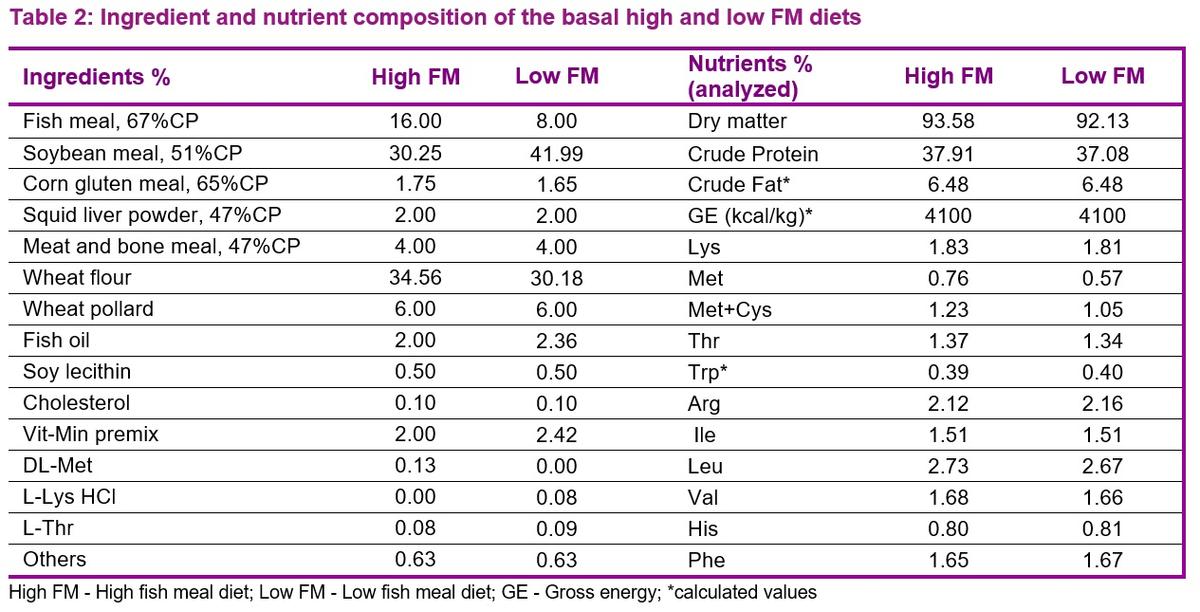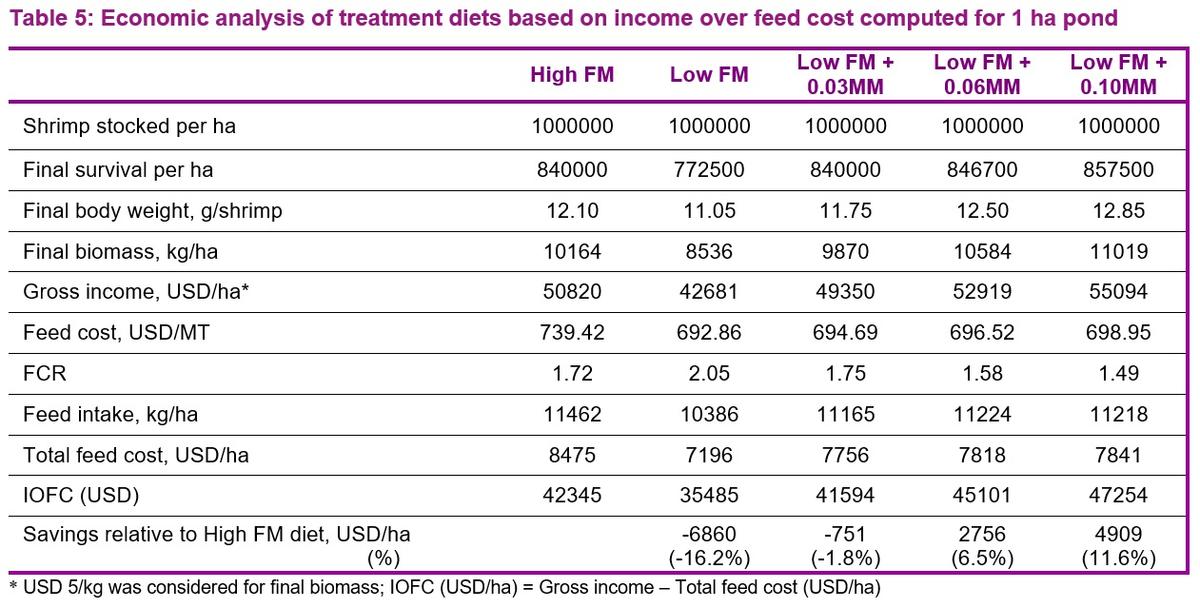Introduction
Fish meal (FM) supply fluctuates mainly owing to El Niño cycle, making their prices to be highly volatile. Efforts continue to reduce the inclusion of FM in aqua feeds to offset their high price and fluctuating supply. Crustaceans accounted for the largest share (30%) of total FM usage in aqua feed sector in 2015 (IFFO 2016). There has been accumulating evidence that FM can be successfully reduced in shrimp feed through balancing of limiting AA (e.g., Facts & Figures Nos. 1625, 1629, 1630, 1631). More studies conducted under different nutritional and production conditions are important for data consolidation across different regions. Replacement of FM with alternative protein sources requires balancing diets for limiting nutrients, while maintaining performance. Methionine (Met) is first limiting amino acid (AA) in shrimp feed and thus, its supplementation is needed to meet Met requirements of shrimp. DL-Methionyl-DL-Methionine, ‘Met-Met’ in short (AQUAVI® Met-Met), is a dipeptide of DL-Methionine and is shown to be an effective supplemental Met source in shrimp feed. The objective of the current study was to evaluate and compare the performance of shrimp fed low FM diet (8%) with increasing levels of supplemental Met-Met, relative to those fed a high FM diet (16%) under intensive culture system. The study was conducted in collaboration with Prof. Agus Suprayudi, Bogor Agricultural University, Indonesia.
Materials and methods
Shrimp (3.47±0.02 g, mean ± SD, initial weight) were stocked in 20 outdoor cages (1×1×1.5 m) installed in a pond at a stocking density of 100/m2. The study evaluated five dietary treatments: a high FM diet containing 16% FM with 0.10% DL-Met supplementation (D1), a low FM diet containing 8% FM without supplemental Met (D2) and the low FM diet supplemented with increasing levels of Met-Met at 0.03%, 0.06%,and 0.10%, respectively for D3, D4 and D5. All the diets were formulated to be isoproteic (35% CP) and isocaloric (4100 kcal). Analyzed Met-Met, Met and Met+Cys levels (as-is basis) of the treatment diets are given in Table 1. Ingredient and nutrient compositions of the high FM (D1) and low FM (D2) diets are presented in Table 2. Each dietary treatment was allocated randomly to four replicate cages and shrimp were fed four times daily to apparent satiation for 42 days. Daily recorded water salinity was 31.73±1.95ppt and water temperature was 28.89±1.77°C. Survival, feed intake, and final body weight were recorded for each replicate cage, and used for calculating body weight gain (g/shrimp), biomass gain (g/cage), specific growth rate (SGR, %/d) and feed conversion ratio (FCR, g feed fed/g biomass gain). Average feed intake for individual shrimp in each cage was calculated by considering biweekly survival data. Retention of dietary protein and AA (CP or AA gain x 100 / CP or AA fed) in the whole-body of shrimp were calculated for the whole biomass in each cage and compared for different treatments. Data were analyzed with ANOVA using PROC GLM procedure (SAS 9.1) and means were separated using Tukey test (P <0.05).

Results and discussions
Growth performances of shrimp fed different diets are shown in Table 3. Shrimp fed the low FM diet with no Met supplementation (D2) exhibited significantly lower body weight and biomass gains, and marginally lower SGR (P=0.06) relative to those fed the high FM, Met supplemented diet (D1). Similarly, feed intake was significantly lower for group fed low FM with no Met supplementation (D2) compared with those fed the high FM diet (D1). However, weight gain, growth rates and FCR significantly improved for the low FM diets when supplemented with increasing levels of Met-Met (D3-D5). Shrimp fed the low FM diet supplemented with 0.06% or 0.10% Met-Met diet showed significantly better performance than those fed the low FM diet with no Met supplementation, and similar performance with those fed the high FM diet (D1). In addition, shrimp fed the low FM diet with 0.1% Met-Met supplementation gained more biomass than those fed the high FM diet (D1). Survival rate ranged from 77 % (D2) to 86 % (D5) without any differences among different treatments. Similar to FCR, low FM diet supplemented with increasing levels of Met-Met showed significant improvements in whole-body protein and AA retention efficiencies. In addition, low FM diet supplemented with 0.10% Met-Met showed significantly better protein and AA retention efficiencies than did the high FM diet.


Economic analysis based on income over feed cost (IOFC) (Table 5) indicate that supplementation of AQUAVI® Met-Met in the low FM diets at 0.06% and 0.10% levels improved economic benefits by 6.5% (USD 2756/ha) and 11.6% (USD 4909/ha) respectively, relative to the high FM diet. Overall, results showed that supplemental AQUAVI® Met-Met is an effective methionine source in shrimp feed and is essential in reducing dietary fish meal level from 16% to 8% without compromising growth performances of shrimp under intensive farming systems.








